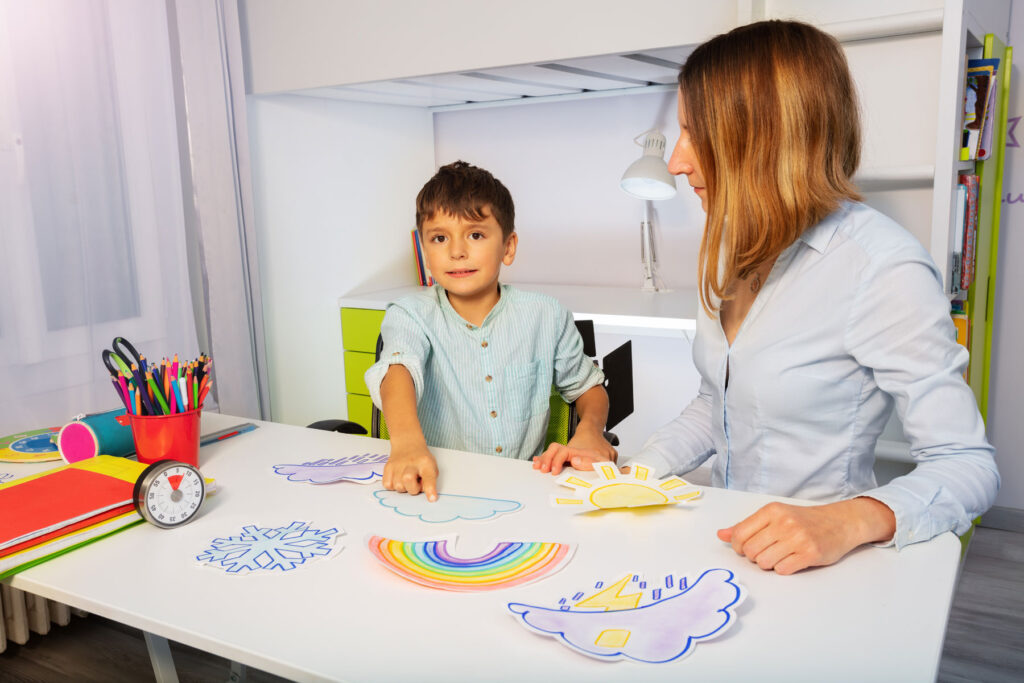Applied behavior analysis (ABA) is a scientific approach committed to understanding and enhancing human behavior. By systematically applying interventions based on the principles of learning theory, ABA aims to bring about meaningful changes in behavior.
Setting clear, concise ABA goals is foundational to this process, as it ensures tailored interventions that address specific needs and foster measurable progress.
At A Gem of Joy, we specialize in creating behavior intervention and behavior support plans that align with these goals, reinforcing positive behaviors while mitigating challenges.
Our dedicated team is here to provide compassionate, professional support tailored to each individual’s unique journey and strengths. Call us at 888.501.6641 today to learn more about A Gem of Joy’s ABA services.
Understanding ABA Therapy Goals
ABA therapy goals are specific, measurable objectives designed to improve the behaviors and skills of learners receiving applied behavior analysis services. These goals serve as the foundation for tailored intervention strategies to foster changes and enhance a client’s quality of life.
Analysts can ensure that the treatment is effective and relevant by aligning ABA goals with each individual’s unique needs and abilities. This personalization is crucial as it considers the individual’s strengths, areas for improvement, and personal aspirations, making the overall treatment approach more holistic and impactful.
Identifying Important ABA Skills
When identifying important ABA skills to target in therapy, it’s essential to focus on areas that will significantly impact the individual’s daily life.
Key skills might include:
- Communication abilities
- Social interactions
- Self-care routines
- Academic tasks
To begin, thoroughly assess the current skill levels through observations, standardized assessments, and input from caregivers and analysts. This comprehensive evaluation helps understand the learner’s existing strengths and pinpoint areas that need development.
Once this baseline is established, setting realistic and achievable goals becomes the next crucial step. These objectives should be specific, measurable, and tailored to the learner’s needs, ensuring that progress is possible and meaningful.
Setting Realistic Timeframes for ABA Goals
When setting realistic timeframes for ABA goals, blending ambition with attainability is critical. Establishing a reasonable timeline keeps the learner and their support team motivated and ensures steady and sustainable progress.
Assessing the Individual’s Pace
Each learner acquires new skills at their own rate, making observing and understanding their natural pace essential. Collaborating with caregivers or other guardians can provide valuable insights into the most effective timing for achieving specific goals.
Breaking Down the Goals
Large, overarching goals should be divided into smaller, manageable steps. This breakdown helps maintain focus and provides regular opportunities to celebrate the learner’s progress, boosting their confidence and reinforcing positive behavior.
Monitoring and Adjusting Timelines
Continuous monitoring of progress is necessary to determine if the established timeline remains appropriate. If a learner progresses more quickly or slowly than anticipated, adjusting the timeline ensures the goals remain realistic and achievable without causing unnecessary frustration or pressure.
Setting realistic timeframes forms the backbone of an effective ABA intervention plan, promoting a structured yet flexible path toward meaningful improvements.
Practical ABA Goals Examples
When crafting practical ABA goals, it’s vital to distinguish between short-term and long-term objectives while ensuring progress is continually monitored. Short-term ABA goals are more immediate and attainable within weeks or months.
For example, a short-term goal might enhance a learner’s ability to request items verbally or through a communication device, aiming for consistent use in daily routines.
Long-term ABA goals span months to years and focus on significant improvements like independence in self-care tasks or advanced social interaction skills. Regular data collection and progress monitoring are essential to meeting these goals.
This includes quantitative measurements, like frequency counts or duration logs, and qualitative observations from caregivers, technicians, and analysts.
Continuous evaluation allows for the adjustment of intervention strategies, ensuring that each goal remains aligned with the learner’s evolving capabilities and needs. By setting these well-defined and measurable goals, ABA analysts and technicians can create a structured yet adaptable roadmap for meaningful behavioral development.
Call A Gem of Joy for Help Setting ABA Goals
Setting attainable ABA goals can lead to significant progress and improvements in a learner’s life. If you or a loved one is seeking ABA therapy services, consider reaching out to A Gem of Joy.
Our team of experienced and compassionate professionals specializes in creating personalized intervention plans tailored to each individual’s unique needs and goals. Contact us online or call us today at 888.501.6641 for more information on our services and how we can help your family through ABA therapy.

